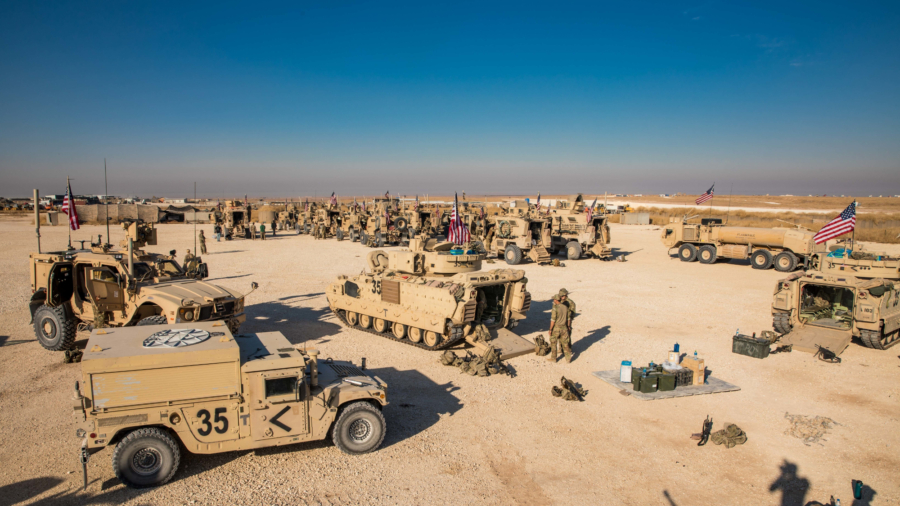U.S. troops stationed in Iraq and Syria have come under four new rounds of rocket and drone attacks from suspected Iran-backed terror groups in the past day, despite a U.S. airstrike intended to dissuade such attacks.
At a Thursday press briefing, Pentagon deputy press secretary Sabrina Singh confirmed U.S. troops in the Middle East were accosted by rockets and explosive one-way drones 46 separate times since Oct. 17, including 24 attacks in Iraq and 22 in Syria. She said at least 56 U.S. service members have been injured in these attacks.
The United States has attributed these recent rocket and drone attacks to groups supported by the Iranian Islamic Revolutionary Guard Corps (IRGC) Quds Force.
U.S. forces have carried out at least two strikes on suspected IRGC targets since Oct. 17, with a strike in Syria on Oct. 27 and another in Syria on Wednesday. A pair of U.S. Air Force F-15 Eagle fighter jets targeted a suspected IRGC weapons facility in the latest strike.
Secretary of Defense Lloyd Austin said these U.S. strikes were done in self-defense and represented the direct response to the dozens of attacks on U.S. troops over the past three weeks.
“By specifically targeting these associated facilities, we seek to convey a clear message to Iran: that we hold it accountable for the attacks on U.S. forces, and we expect Iran to take measures to direct its proxies to stop. Our military actions do not signal a change in our approach to the Israel–Hamas conflict, and we have no intention of escalating this conflict in the region,” Ms. Singh added on Thursday.
But despite the stated intention of dissuading Iran and its proxies, attacks on U.S. forces in the region appeared to continue in the hours after Wednesday’s self-defense strike.
CNN reported attackers fired rocket barrages at U.S. and coalition troops at the Omar Oil Fields near Mission Support Site Green Village in Syria twice on Wednesday evening. A third attack came by way of an explosive-laden drone piloted toward Mission Support Site Euphrates in Syria on Wednesday evening and a fourth attack came on Thursday morning when an explosive drone targeted forces stationed at Al-Asad Airbase in Iraq.
“I can confirm that there have been four additional attacks since the U.S. military took our self-defense strike last night. That’s correct. One in Iraq and three in Syria,” Ms. Singh said on Thursday.
Ms. Singh said the United States could order additional airstrikes if the Pentagon deems it necessary.
“If these attacks continue against our personnel, we won’t hesitate to take further necessary measures to protect our people and to do so at a time and place of our choosing,” she said.
Reaper Drone Shot Down Near Yemen
In addition to the rocket and drone attacks targeting U.S. troops in Iraq and Syria, a U.S. MQ-9 Reaper drone was shot down in international airspace off the coast of Yemen on Wednesday.
The Houthi rebel movement in Yemen initially claimed responsibility for shooting down the U.S. drone. In a press statement shared with NTD News, a DOD official confirmed the drone had been destroyed and that the Houthis were to blame.
The Houthis, also known as Ansrallah, are a Zaydi Shiite movement that has intermittently fought with Yemen’s internationally recognized government since 2004. The conflict expanded after the Houthis took over the Yemeni capital of Sanaa in September 2014, bringing on a civil war that has seen Saudi Arabia and other gulf states intervene on behalf of the Yemeni government. The U.S. State Department has assessed Iran to be actively supplying the Houthi side with advanced weapons.
The Trump administration had designated the Houthis as a foreign terrorist organization during his last days in office, but President Joe Biden reversed that designation in February of 2021.
In addition to downing the U.S. drone on Wednesday, the Houthis have also recently waded into the ongoing Israel–Hamas conflict, claiming to have launched ballistic missiles and one-way drones at Israel.

